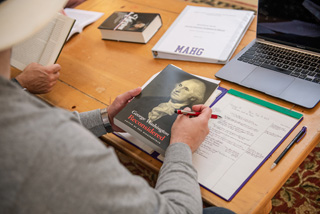
MAHG Qualifying Exam Tips
Summer has arrived! And that means TAH’s most comprehensive professional development program—our Master of Arts in American History and Government (MAHG) program—is now in residence at Ashland University in Ashland, OH.
Every summer, hundreds of teachers from around the country join us for week-long classes on topics ranging from early American history to modern political institutions. The one-day seminars we hold around the country provide in-depth learning through document-based discussions, but the experience is amplified during the summer residential program.

There’s the obvious benefit of more time. A summer residential seminar gives you five and a half days to develop your expertise in the topic you’re interested in. But that’s just the start. Teachers and professors live together on campus, sharing meals and continuing the discussions outside of class. Add to this the serenity and seclusion of our campus, and it’s no wonder so many incredible teachers keep coming back every summer.
But all good things eventually end, and some of our students will be finishing their final classes this summer. Teachers at the end of the program can choose to complete either a traditional master’s thesis, a capstone project, or our qualifying exam. With the qualifying exam being the option most of our students choose, we’d like to take a look at the structure of this exam and how to perform well on it.
The exam will be released to students on a Friday, and they will have a little over two weeks to submit their final answers. The exam has two parts.
- The first part asks students to analyze a short text.
- The second part consists of four questions on a variety of topics, eras, or themes in American history and government. Students answer two of these questions.
Both parts of the exam contain document excerpts that you are asked to analyze. To do well on the exam, you must understand that Part I is asking for a different, more focused, kind of document analysis than Part II is asking for.
How to Succeed on Part I
In the first part of the exam, all that is required is that you give an accurate and thorough account of the argument in the document. What program of action, view of a policy question, analysis of a social issue, or other claim is the author presenting? How does the author make his or her case? Focus on the steps in the author’s argument. Don’t try to explain the historical situation that caused the author to write. Don’t try to recount other arguments being made by other authors writing at the same time.
When teachers fail on this part of the exam, it is usually because they have tried to write about the historical context of the document and forgotten to provide this basic analysis. What you need to do is to walk the person reading your exam through what the document actually says. The prompt for Part I will ask specific questions that should guide you in your analysis.
How to Succeed on Part II
In the second part of the exam, you may be given one document excerpt to analyze, or you may be given two to compare and contrast. In either case, your analysis should be broader than in Part I of the exam. Since your aim here is to comment on a topic or theme in American history or government, you will need to place the document excerpts into their historical contexts. For example, you should answer such questions as:
- For what purpose was the document written?
- Who was its intended audience?
After answering these questions about a document, explain what the document says. Then you might answer the questions:
- What effect did the document have on its intended audience?
- Did it achieve its author’s purpose?
Above all, be sure to do what you always tell your own students to do: Answer the question asked in the prompt!
Remember also that, when we read primary sources, we try to understand others as they understood themselves. Their writings may not persuade everyone who reads them today. Even at the time they wrote, their writings may have fallen short of their goals. While you may mention these effects of the documents, be sure to give careful attention to what the authors hoped to accomplish.
Strategies for Success
Sometimes teachers run out of time to complete their essays. We encourage you to take full advantage of all three weekends between the release of the exam and its submission deadline. Start right away to give yourself time to proofread, revise, and edit later.
Save your notes from class! If you’re not a pack rat and can’t save them all, you should at least consider saving notes from the core or required courses in our program (501, 502, 503, 505, 506, and 507). These courses lay an excellent foundation for a deep understanding of the history and government of America. From the American Revolution through the Rise of Modern America, you’ll have plenty of material to draw from to help you answer the questions in your essay.
Take breaks in your writing; rest and revisit it later. It may feel like you don’t have time for this, but you’ll benefit from looking back over your work with a fresh set of eyes. If you start writing that first weekend you get the questions, you’ll have a chance to try out your first ideas. Later, after you’ve had time to reflect more on the document excerpts and what you’d like to say about them, you might decide to rewrite what you wrote before. You might open with a new thesis statement. Or you may want to add more analysis, give more examples of the points you want to make, or rewrite sentences that are not clear.
Get feedback from the friends you’ve made in the program. We always encourage our students to form study groups for their classes on campus, so as you work on the exam, continue to make use of the connections you’ve made. Someone familiar with our classes will help you see if you’ve strayed into irrelevance in your answer.
It can also be helpful to ask people with no knowledge of the topic to proofread your essay for you. English teachers you work with can offer valuable feedback on the coherence of your answers without getting lost in the technicalities of the content. Additional sets of eyes reading back through what you wrote will help you know whether you’ve fully addressed the prompt and thoroughly analyzed the document.
Take Pride in the Process
The Qualifying Exam may be intimidating, but as with all of the challenges in the MAHG program, it’s a rewarding way to finish your studies. It will remind you how much you learned over the years in our program. You’ll leave with that familiar sense of pride when you push your brain to its limits thinking through topics worthy of serious study.



